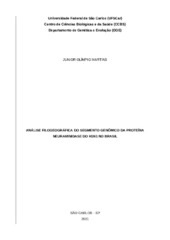| dc.contributor.author | Martins, Junior Olimpio | |
| dc.date.accessioned | 2022-04-25T13:08:26Z | |
| dc.date.available | 2022-04-25T13:08:26Z | |
| dc.date.issued | 2022-04-18 | |
| dc.identifier.citation | MARTINS, Junior Olimpio. Análise filogeográfica do segmento genômico da proteína neuraminidase do H1N1 no Brasil. 2022. Trabalho de Conclusão de Curso (Graduação em Biotecnologia) – Universidade Federal de São Carlos, São Carlos, 2022. Disponível em: https://repositorio.ufscar.br/handle/ufscar/15898. | * |
| dc.identifier.uri | https://repositorio.ufscar.br/handle/ufscar/15898 | |
| dc.description.abstract | Seasonal flu, caused by Influenza viruses, is one of the most prevalent viral infections in the world, causing 290-650 thousand deaths annually. Such viruses, whose genome is composed of negatively oriented single-stranded RNA segments, have high mutational rates and the ability to rearrange between segments, allowing them to rapidly escape immune and even the emergence of pandemic strains. After the implementation of SINAN Influenza in Brazil in 2009, there was a large increase in the number of genomes sequenced and the unification of reported cases, allowing phylodynamic analyzes to be carried out on the sequences of the viruses collected in the country and their correlation with epidemiological data. During the present Course Completion Work, the objective was to study the molecular evolution and epidemiology of the Influenza A H1N1 virus in Brazil, using the genomic segment that encodes neuraminidase as a model. Through this approach, it was possible: (i) to calculate the mutational rate of the segment (3.02 x 10-3 substitutions/site/year) in accordance with the existing literature; (ii) identify variations in population sizes correlated with flu seasons with an increase in the number of cases; and (iii) even identify the southern region as a seedbed of flu strains in 2009. These results, despite not including the impact of the rearrangement, provide important information about the epidemiology and evolutionary parameters of seasonal influenza A H1N1 in Brazil. | eng |
| dc.description.sponsorship | Conselho Nacional de Desenvolvimento Científico e Tecnológico (CNPq) | por |
| dc.language.iso | por | por |
| dc.publisher | Universidade Federal de São Carlos | por |
| dc.rights | Attribution-NonCommercial-NoDerivs 3.0 Brazil | * |
| dc.rights.uri | http://creativecommons.org/licenses/by-nc-nd/3.0/br/ | * |
| dc.subject | Gripe | por |
| dc.subject | Influenza A | por |
| dc.subject | Neuraminidase | por |
| dc.subject | Filogenética | por |
| dc.subject | Filogeografia | por |
| dc.title | Análise filogeográfica do segmento genômico da proteína neuraminidase do H1N1 no Brasil | por |
| dc.title.alternative | Phylogeographic analysis of the genomic segment of Neuraminidase of H1N1 in Brazil | eng |
| dc.type | TCC | por |
| dc.contributor.advisor1 | Freire, Caio Cesar de Melo | |
| dc.contributor.advisor1Lattes | http://lattes.cnpq.br/6594298373448536 | por |
| dc.description.resumo | A gripe sazonal, causada pelos vírus Influenza, é uma das infecções virais mais prevalentes no mundo, causando 290-650 mil óbitos anuais. Tais vírus, cujo genoma é composto por segmentos de RNA fita simples negativamente orientada, possuem elevadas taxas mutacionais e a capacidade de rearranjo entre segmentos, permitindo-lhes rápido escape imune e mesmo o surgimento de linhagens pandêmicas. Após a implantação do SINAN Influenza no Brasil, em 2009, houve um grande aumento no número de genomas sequenciados e a unificação dos casos notificados, permitindo a realização de análises filodinâmicas sob as sequências dos vírus coletados no país e sua correlação com dados epidemiológicos. Durante o presente Trabalho de Conclusão de Curso, objetivou-se estudar a evolução molecular e a epidemiologia do vírus Influenza A H1N1 no Brasil, usando como modelo o segmento genômico que codifica a neuraminidase. Por meio desta abordagem, foi possível: (i) calcular a taxa mutacional do segmento (3.02 x 10-3 substituições/sítio/ano) em acordo com a literatura existente; (ii) identificar variações nos tamanhos populacionais correlatas a estações gripais com aumento no número de casos; e (iii) mesmo identificar a região Sul como semeadora de linhagens gripais em 2009. Tais resultados, apesar de não incluírem o impacto do rearranjo, fornecem importantes informações sobre a epidemiologia e parâmetros evolutivos da gripe sazonal por Influenza A H1N1 no Brasil. | por |
| dc.publisher.initials | UFSCar | por |
| dc.subject.cnpq | CIENCIAS BIOLOGICAS::MICROBIOLOGIA::BIOLOGIA E FISIOLOGIA DOS MICROORGANISMOS::VIROLOGIA | por |
| dc.publisher.address | Câmpus São Carlos | por |
| dc.contributor.authorlattes | http://lattes.cnpq.br/9569757382824595 | por |
| dc.publisher.course | Biotecnologia - Biotec | por |

